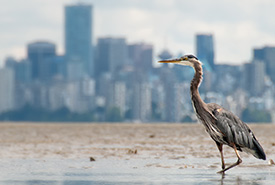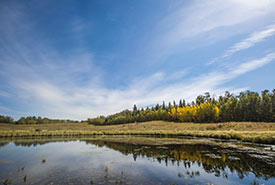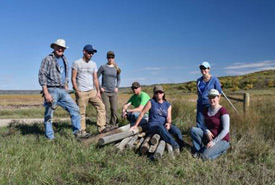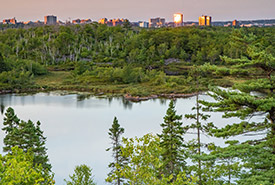World Habitat Day 2021: There is no protected habitat too small to benefit biodiversity

Great blue heron with a cityscape in the background (Photo by iStock)
October 4 is World Habitat Day, which has been celebrated annually by the United Nations since 1986. This year’s theme is accelerating urban climate action. The day is followed by Urban October, a month where we are encouraged to reflect on the state of our towns and cities.
As a conservation biologist, you might not think that I put much thought into cities and towns. But urban nature is incredibly important for lessening the impacts of climate change, supporting biodiversity and supporting human well-being.
This summer, I attended the Canadian Society for Ecology and Evolution annual meeting (virtually). The recipient of the 2021 President’s Award for Research Excellence, professor Lenore Fahrig, gave a thought-provoking talk about her work on habitat fragmentation. She advocated for the urgent need for habitat conservation and restoration in fragmented, human-dominated landscapes, including urban areas.
Habitat fragmentation is exactly what it sounds like: the breaking apart of habitat. It results in several smaller patches of habitat, rather than one large area. Fragmentation should not be confused with habitat loss; habitats can be fragmented without losing any habitat. Think of a new highway cutting across a wilderness area, fragmenting this single large habitat into two smaller sections.
Lenore argued that no evidence exists that supports the widespread assumption that several small habitat patches have lower biodiversity than a single large patch with the same total area. This does seem counterintuitive, which is maybe why it’s so hard to believe. But Lenore has spent her career researching this question, and her conclusion is well supported. Keeping total habitat area consistent, several small protected areas are just as good for biodiversity as a single large protected area. But more habit is always better.

Beaver Hills, AB (Photo by Brent Calver)
Why does this matter anyway? Because it shows the importance of conservation efforts at all scales. At the Nature Conservancy of Canada (NCC), we know this. We work in both large, contiguous wilderness areas, such as Darkwoods Conservation Area and Vidal Bay, and smaller, but no less important, “fragments,” such as the Beaver Hills and Montreal’s Greenbelt. Together, these protected areas, small and large, add up to a lot of nature conserved: 14 million hectares (35 million acres) since NCC was founded in 1962.

Volunteers pulling together for conservation work. (Photo by Gail F. Chin)
Of course, there are ways in which the method of fragmentation can be harmful to animals on the landscape, even if it doesn’t lower biodiversity. For example, a highway cutting across a wilderness area presents a mortality risk to individuals attempting to cross. At NCC, we are constantly working to improve connectivity between patches so animals can safely move across the landscape, whether by removing unwanted fencing or installing wildlife crossing structures, for example.

Colpitt Lake inside the Halifax Wilderness Park (Photo by Adam Cornick)
Returning to cities, the implications of Lenore’s work are exciting. If even small, fragmented patches of habitat are important for biodiversity conservation, we can no longer overlook cities. Every patch of native habitat counts, including your favourite local forest or wetland. I suspect the same for climate action; every area of natural habitat, no matter how small, makes a difference. Urban areas are usually treated as the problem driving habitat loss and climate change, but Lenore’s conclusions embolden us to use urban areas as part of the solution.
I hope you will take this World Habitat Day and the month of October to reflect on the small patches of nature in your urban area and the many ways they support biodiversity, fight climate change and improve your well-being.


